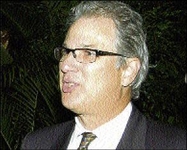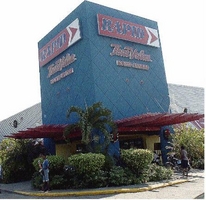Pan Jam 'deeply concerned' about H&L investment
Published: Wednesday | May 20, 2009


Left: Joe Taffe, deputy CEO of GK Investments, says focus will be placed on working capital management and inventory control to drive down costs. Right: Pan Jam President and CEO Stephen Facey says the firm is willing to stick with its underperforming H&L investment.
For the past three years, conglomerate GraceKennedy Limited has been experimenting with different strategies for struggling subsidiary Hardware and Lumber Limited, and while there have been periods of sunshine, nothing has worked so far to put the company on a sustained path to profitability.
Now the Facey family, who are key shareholders, appears to be getting weary of the trials and H&L's descent into losses that have begun to tell on Pan Jamaica Investment Trust Limited's balance sheet.
Last year, Pan Jam - the second-largest shareholder in H&L with 16.8 million shares or 20.83 per cent of the company - wrote off $58 million as impairment loss linked to H&L, which ended the year $286 million in the red.
Just months ago, in a statement to shareholders issued with the company's annual report in March, Pan Jam Chairman Maurice Facey and President and Chief Executive Stephen Facey disclosed their concern to shareholders albeit in a tempered fashion.
"We are actively engaged on the company's board of directors and with management in reviewing strategic alternatives, and to turn around this underperforming investment," said the father-son duo in a statement published in the annual report.
But then H&L, which operates Jamaica's largest hardware and home centre chain, Rapid True Value, racked up more losses of $113 million in the three-month period ending March 2009, obliterating five times over the $22 million of profit made in the similar period of 2008.
The Faceys' tone was decidedly different last week, more grave, when in a statement issued at its May 14 annual general meeting, Pan Jam reported even more write-downs after a poor first quarter for H&L.
"Revenue declines in the wholesale and retail segments, high expense levels, and exposure to US-dollar debt all hurt results," said Pan Jam.
"We remain deeply concerned about the outlook for this business and have recorded an impairment loss this quarter to reduce our carrying value to the current trading level of $5 per share."
Still Stephen Facey said the company would be hanging on to the investment while reiterating that Pan Jam would work with H&L on its turnaround strategies.
A year ago, H&L was trading at $17 per share. Indeed, the stock's market value has fallen 50 per cent calendar year to date.
Correspondingly, the value of 'investment in associated companies' on Pan Jam's balance sheet dropped from $4.84 billion at December 31, 2008 to $4.8 billion at March 31, 2009.
At the $5 price, Pan Jam's H&L investment is currently valued at $84.2 million.
Vacancy
The younger Facey is a director on the H&L board that was, up to March 2, chaired by GraceKennedy CEO Douglas Orane, who gave up his seat to make way for other GK talent.
Erwin Burton, who heads GK's Food Division and was on the board, was elevated to the chair, while Courtney Campbell, who runs GK Investments, was appointed to fill the vacancy left by Orane.
The movements came two months behind the roll-out of a restructuring plan to cut costs at the company - the latest turnaround plan that up to then was more focused on technology-driven efficiencies.
In 2006, H&L implemented a new management information system but found that it failed to deliver - or as the company put it, the technology was "proven to be inadequate and inefficient".
That system was replaced in 2008 with the S2K Enterprise, developed by Vormittag Associates of New York, to drive efficiencies in H&L's supply and distribution chains, including procurement, and inventory management and control. S2K is meant to create synergies that allow the hardware company to better estimate what its customers want to buy and to have those products available on the shelves at the right time.
Still, the underperforming associate, though it may have impacted profits, was not enough to restrain the property company's growth. Pan Jam made $1.6 billion in 2008, compared to $1.3 billion in 2007. In the first quarter of 2009, net income rose to $568 million, of which $160 million came from minority interests, compared to the first quarter of 2008, when profits were $372.8 million, $100 million from minority partners.
Impacting profits was a $139 million charge for debt servicing, which included $99 million in foreign exchange losses linked to the depreciation of the local dollar now trading at about J$89.
Four of five long-term loans are USD-denominated, but H&L Chief Executive Anthony Holness said the company would be replacing the foreign-currency debt with JMD financing to mitigate foreign exchange risk.
The company has $1.1 billion in outstanding loans, the majority of which, $767.3 million, is due within a year.
H&L's stock market value has, in a year, dropped to $404 million, even as its net worth declined in the first quarter from $1.12 billion to $1 billion at balance sheet date March 2009; and while its asset base narrowed slightly from $1.66 billion to $1.58 billion at balance sheet date March 31.
Efforts to restrain costs included the closure of a branch in St Ann's Bay in March 2007.
More recently, H&L announced a cut in staff and a consolidation of stores to drive efficiencies up and costs further down, but none of these efforts, including the technological switch, have yet impacted the company's bottom line.
Top-line income also declined by 19 per cent, year on year, from $1.79 billion to $1.5 billion.
On Friday, at a GraceKennedy investors' briefing, Joe Taffe, the deputy CEO of GK Investments, acknow-ledged that the conglomerate's trading division, which includes Rapid True Value and Agro Grace stores, was experiencing challenges, reflective of the current economic environment, but added that "the months of March and April have shown some signs of improvements".
Going forward

A Rapid True Value home centre in Kingston. - File
Strategies going forward include working-capital management and control of operating expenses.
Orane, in discussions earlier this year with this newspaper on the future of the company, said GK has no plans to offload the company.
H&L's troubles began to manifest back in mid-2000 when a cement scare sent the construction market into a tailspin.
Within this decade, the hardware company's profits peaked at $156 million in 2004, but dropped off again in the next two years to $20 million and $37.7 million.
H&L appeared to have been on the road to recovery in 2007 when it returned its second-largest profits of $133 million on peak revenues of $6.6 billion. But that euphoria evaporated in 2008 when the company reported its first loss of $285.6 million - large enough to erase the hardware company's two biggest yearly profits.
Facey blamed the overhang from the cement crisis and subsequent shortages, and the more recent economic downturn - which has seen construction GDP contract 5.2 per cent in calendar 2008, and seven per cent in the first quarter of 2009 - for H&L's troubles.
"I think that there has been a series of events that contributed to the poor performance of Hardware and Lumber," he said.
"We are working with the directors to turn the company around, making the necessary changes to return to profitability."
business@gleanerjm.com














